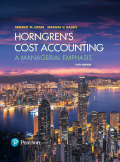
EBK HORNGREN'S COST ACCOUNTING
16th Edition
ISBN: 9780134475950
Author: Datar
Publisher: PEARSON CO
expand_more
expand_more
format_list_bulleted
Question
Chapter 2, Problem 2.48P
To determine
Cost:
Cost refers to the expenses incurred by the business to earn revenue from sales, in other words cost is the amount given in order to get something.
To identify: The values of A, B, C and D.
Expert Solution & Answer
Want to see the full answer?
Check out a sample textbook solution
Students have asked these similar questions
Help
Do fast answer of this accounting questions
Hello tutor please give me correct answer general Accounting
Chapter 2 Solutions
EBK HORNGREN'S COST ACCOUNTING
Ch. 2 - Define cost object and give three examples.Ch. 2 - Define direct costs and indirect costs.Ch. 2 - Prob. 2.3QCh. 2 - Name three factors that will affect the...Ch. 2 - Define variable cost and fixed cost. Give an...Ch. 2 - What is a cost driver? Give one example.Ch. 2 - What is the relevant range? What role does the...Ch. 2 - Explain why unit costs must often be interpreted...Ch. 2 - Prob. 2.9QCh. 2 - What are three different types of inventory that...
Ch. 2 - Distinguish between inventoriable costs and period...Ch. 2 - Define the following: direct material costs,...Ch. 2 - Describe the overtime-premium and idle-time...Ch. 2 - Define product cost. Describe three different...Ch. 2 - What are three common features of cost accounting...Ch. 2 - Prob. 2.16MCQCh. 2 - Comprehensive Care Nursing Home is required by...Ch. 2 - Frisco Corporation is analyzing its fixed and...Ch. 2 - Year 1 financial data for the ABC Company is as...Ch. 2 - The following information was extracted from the...Ch. 2 - Computing and interpreting manufacturing unit...Ch. 2 - Direct, indirect, fixed, and variable costs....Ch. 2 - Classification of costs, service sector. Market...Ch. 2 - Classification of costs, merchandising sector....Ch. 2 - Classification of costs, manufacturing sector. The...Ch. 2 - Variable costs, fixed costs, total costs. Bridget...Ch. 2 - Variable and Fixed Costs. Consolidated Motors...Ch. 2 - Variable costs, fixed costs, relevant range. Gummy...Ch. 2 - Prob. 2.29ECh. 2 - Cost drivers and functions. The representative...Ch. 2 - Total costs and unit costs, service setting....Ch. 2 - Total and unit cost, decision making. Gayles...Ch. 2 - Inventoriable costs versus period costs. Each of...Ch. 2 - Computing cost of goods purchased and cost of...Ch. 2 - Cost of goods purchased, cost of goods sold, and...Ch. 2 - Flow of Inventoriable Costs. Renkas Heaters...Ch. 2 - Cost of goods manufactured, income statement,...Ch. 2 - Cost of goods manufactured, income statement,...Ch. 2 - Income statement and schedule of cost of goods...Ch. 2 - Interpretation of statements (continuation of...Ch. 2 - Income statement and schedule of cost of goods...Ch. 2 - Terminology, interpretation of statements...Ch. 2 - Labor cost, overtime, and idle time. David...Ch. 2 - Missing records, computing inventory costs. Ron...Ch. 2 - Comprehensive problem on unit costs, product...Ch. 2 - Prob. 2.46PCh. 2 - Cost classification; ethics. Paul Howard, the new...Ch. 2 - Prob. 2.48P
Knowledge Booster
Similar questions
arrow_back_ios
SEE MORE QUESTIONS
arrow_forward_ios
Recommended textbooks for you
 College Accounting (Book Only): A Career ApproachAccountingISBN:9781337280570Author:Scott, Cathy J.Publisher:South-Western College Pub
College Accounting (Book Only): A Career ApproachAccountingISBN:9781337280570Author:Scott, Cathy J.Publisher:South-Western College Pub

College Accounting (Book Only): A Career Approach
Accounting
ISBN:9781337280570
Author:Scott, Cathy J.
Publisher:South-Western College Pub